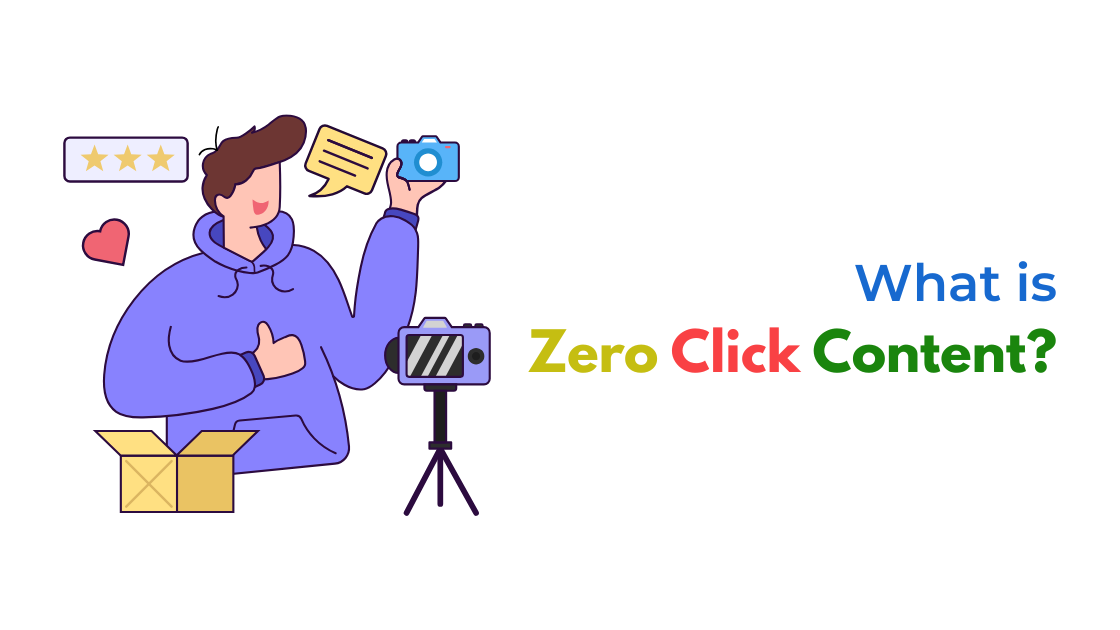In the ever-shifting landscape of social media, SEO and content marketing, one term is rapidly becoming central to winning attention and building brand equity: zero click content.
In this blog, we’ll break down what zero click content means, why it’s so powerful in social media and platform ecosystems, and most importantly how you can use it in 2026 to surpass competitors and build social traction.
What is zero click content?
At its simplest, zero click content is content that delivers its full value without requiring the user to click away to another link, page or site.
The user gets what they need right in the platform or feed.
- For example: a LinkedIn carousel that teaches a concept slide by slide, a short Instagram Reel that gives a tip, or an X (formerly Twitter) thread that shares a mini-case in one go. sparktoro.com
- Historically the term originated in the search/SEO world (when users got answers in the SERPs and didn’t click through) but it’s now very relevant to social media. Social Media Dashboard
- In the search context, zero click content means a user sees the answer in the search results page (featured snippet, knowledge panel, etc) without clicking. Mailchimp
So when we talk about creating zero click content for social, we’re saying: create posts that stand alone, deliver value, keep the user on the platform, minimise friction—and as a result often perform better.
 Why zero click content matters (especially in 2026)
Why zero click content matters (especially in 2026)
1. Social platforms favour content that keeps users on-platform
Algorithms increasingly penalise posts that send people away (via external links) and reward native content. For example: experiments show posts without links on platforms like X and LinkedIn outperform link-out posts. Social Media Dashboard
Moreover, one test showed up to 10 × reach when using this content (no external link) over standard link posts. sparktoro.com
That means if you’re still relying primarily on “See link in bio” or external blog-traffic-driven posts, you’re potentially missing the algorithmic boost that this content offers.
2. User behaviour has changed – less tolerance for clicks
Scrolling behaviour is faster, attention spans shorter, and users feel friction when asked to leave the platform.
According to research:
- 80% of consumers rely on zero-click results in at least 40% of their searches. Bain
- Users don’t love being redirected via links while scrolling through social. Posts that deliver value immediately are favoured. Buffer
Hence zero click content aligns with how users want to consume content: fast, self-contained, platform native.
3. Brand visibility & trust build even when clicks drop
The traditional metric of “click through to website” is under pressure. But zero click content allows brands to maintain visibility, authority and engagement within the platform.
For example: with search, if users get answers without clicking, you may see less website traffic—but you still gain brand exposure and credibility. studioid.com
In social, being present in user feeds with value-rich posts builds community, not just traffic.
4. It sets you up for 2026 and beyond
As platforms evolve, link-out behaviour is going to become less rewarded.
The next few years are going to emphasise platform happiness (keeping users engaged inside) and creator/brand content which drives that.
Thinking “zero click” now positions you ahead of the curve rather than reacting later.
 How to implement zero click content in your social strategy
How to implement zero click content in your social strategy
Here’s a step-by-step framework to make zero click content work for you in 2026:
Step 1: Define what “value” means for your audience
This type of content must stand alone — the user should leave the post understanding or having learned something. Ask yourself:
- What question am I answering?
- Could this be consumed entirely inside the platform without needing a link? Social Media Dashboard
For example: a carousel with 5 slides: “5 common mistakes in social ads + how to fix them” is excellent zero click content. The value is inside.
Step 2: Choose the right format
Depending on platform:
- LinkedIn: text posts, document carousels with complete story inside, native video.
- Instagram: carousels, Reels, single-images with strong caption.
- TikTok / X: short videos or threads that deliver insights fast.
Make sure your format doesn’t force a click out. Socialinsider
Step 3: Hook upfront, deliver quickly
Because attention is scarce, your content needs to capture users fast. Tips:
- Start with the “punchline” or main insight. Social Media Dashboard
- Keep the content concise yet complete.
- Avoid “read more at link in bio” or anything that undermines the standalone value.
Step 4: Minimise external links, focus on engagement
To maximise the algorithmic benefit:
- Avoid external links in the post (or put links in comments).
- CTA could be “save this post”, “share if you found this useful”, “comment your experience”.
- Measure engagement (shares, saves, comments) more than clicks. Buffer
Step 5: Build a mix – zero click + link content
Zero click content doesn’t replace all content.
You still need conversion-driving posts, blog links, etc.
But allocate a strategic portion of your calendar to zero click posts that build reach and brand. Social Media Dashboard
In 2026 your social mix might look like:
- 60% zero click content (brand, insights, platform native)
- 30% link-out content (blog, landing page)
- 10% conversion-driven (offers, audiences)

Example ideas of zero click content you can deploy
Here are practical use-cases you could adopt:
- Instagram carousel: “7 micro-actions for higher engagement this week” (each slide = one micro-action)
- LinkedIn document: “Case study how we scaled a campaign 3× in 30 days (no link required)”
- TikTok/Instagram Reel: “30-second tip: Why you should rethink your CTA structure”
- X thread: “Thread: ⚠️ 5 myths in social ad targeting BUSTED”
Each of those delivers full value inside the post itself and doesn’t require the user to click away.

Metrics and what success looks like for zero click content
Since you’re not driving clicks in that post, your metrics shift. Key measures:
- Engagement rate (likes + comments + shares + saves)
- Reach and impressions (the algorithm rewards content that keeps people on-platform)
- Saves/shares (indicative of value)
- Follower growth/brand visibility
Note: even if website traffic doesn’t spike, you’re still building brand equity and community trust via zero click content.
 Common pitfalls to avoid
Common pitfalls to avoid
- Posting a teaser with “see link in bio” and minimal value: that’s not zero click content.
- Over-linking in the post, penalising algorithmic reach.
- Assuming zero click means “low value”: it actually means high value delivered instantly. Reuben Rink
- Ignoring mix strategy: if you only do zero click content, you may neglect conversions.
- Not measuring the right metrics: clicks will drop for those posts — engagement matters more.
 Why zero click content gives you an edge in 2026
Why zero click content gives you an edge in 2026
- Algorithmic advantage: Platforms increasingly reward content that keeps users inside the app. If you adopt zero click content, you’re optimising for the algorithm rather than fighting it.
- User‐first experience: By respecting users’ time and attention (giving value instantly), you build trust and authority.
- Brand building over quick hits: Instead of focusing purely on click-through traffic, you’re investing in long-term visibility and community.
- Less reliance on external shifts: If your success isn’t dependent on how Google or Facebook treat outbound links, you become more resilient.
- Stand-out in the feed: Many brands still cling to “link in bio” and external traffic metrics. By shifting to zero click content, you differentiate.
Next-level tactics: how to scale this content
- Repurpose content: Turn a blog post into a 10-slide carousel.
- Leverage UGC and mini-stories: User stories make powerful zero click posts when they are self-contained.
- Test formats: Short videos, document uploads, plain-text posts, track what format your audience engages with most.
- Use platform native features: For example, LinkedIn documents, Instagram Reels, threads on X.
- Train your team: Shift your content brief to ask: “Does this post deliver value without clicking?”
- Monitor insights: Over time, you can build a library of zero click posts that steadily boost organic reach, then layer in link-out posts strategically.
Conclusion
In a world where zero click content is becoming a critical lever for social success, Socinova is your partner to execute this strategy smartly and efficiently.
With Socinova you can:
- Audit your existing content mix and identify how many posts are truly zero click vs link-out.
- Design a content calendar focused on platform-native formats, optimised for engagement and standalone value.
- Use analytics dashboards that track the right metrics (engagement, reach, saves/shares) rather than just clicks.
- Get support with creative assets (carousels, short videos) tailor-made for zero click performance.
- Scale content in a way that aligns with algorithmic shifts, audience behaviour and your brand’s growth goals.
Finally, in short: when you adopt this content as a centrepiece of your 2026 strategy, Socinova gives you the tools, insights and execution capability to win, not just in clicks, but in reach, influence and brand building.




